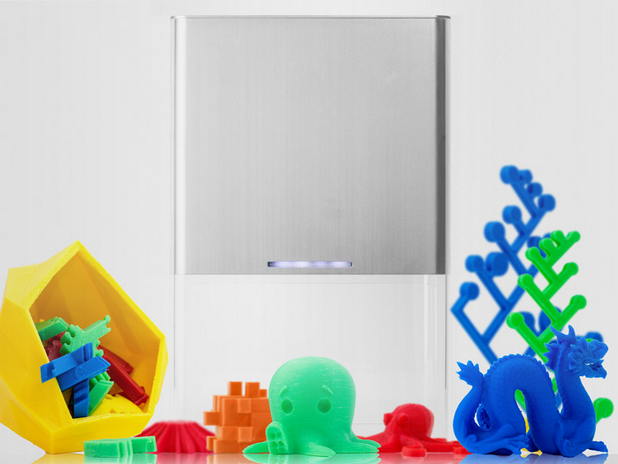It's time to grow up: how disappointed I am in crowdfunding
I have a sad anniversary here. No, I do not celebrate the first year in the outset or the decade since the first divorce. Everything is much easier. But in a sense, no less dramatic. Recently, I financed my 100th project on Kickstarter.

For three years I spent about $ 30,000 on crowdfunding. Perhaps this gives me some right to consider myself a veteran. And like any normal veteran, I want to grumble a little. Although, I'm afraid, rather I will get a cry from the heart.
')
When I first got into Kickstarter in 2011, I was inspired by the idea of crowdfunding. Working in Panasonic, I knew firsthand how little multinational corporations are making efforts to make something truly innovative. And then I saw that, thanks to the crowdfunding, any talented techie could inspire backers with his idea, raise money, start a company and give the world something truly new.
I began to invest in promising projects. He sat on the "Kickstarter" for hours. I was looking for great innovations. Discussed various crazy ideas. I spent the money and waited for the parcels, like a child of Christmas gifts. From all this madness, and was born online store MadRobots. The opportunity to give money to the authors of a unique device, which I will soon be able to sell in Russia through my store, seemed to me inspiring.
But gradually, enthusiasm gave way to disappointment. I financed a hundred projects, and in the end I managed to get no more than half of the devices. Having collected a tidy sum, many inventors simply could not cope with the production and ingloriously merged their promising ideas.
Kickstarter is not a Mecca of innovation, as it seemed at first. More he looks like a fashionable crowd of self-confident amateurs.

The company Radiate Athletics promised to produce T-shirts that will change color depending on the physical activity of the owner. In April 2013, the project collected 579 thousand dollars, and in August 2013, wonderful T-shirts should have been sent to their owners. Ay, where are you, Radiate Athletics? Why has almost a year passed, and I have never seen my T-shirt in the eyes?

The ZoPro project promised to create an iPhone case with a built-in battery and external lenses. Covers were supposed to come backers in February 2013, but all that came out was an update from the creators of the project, where they write that they will bring it to the end at any cost.

Buccaneer - one of the most anticipated 3D printers of 2014, which I personally was waiting for in April, does not seem to appear until Christmas. When testing the printer for certification, it turned out that its electronics was too weak. As a result, developers had to redo the printer almost from scratch.
We pinned many hopes on the Lakitron company, which invented a lock that can be controlled from a smartphone. We corresponded with innovators for a long time and agreed that in November 2013 we would pay them a lot of one hundred pieces, and in a month they would ship it to us. At that time, the company had already started sending its brainchild around the world.
Not expecting a dirty trick, we paid 15 thousand dollars. And what? Lakitron soon declared that a marriage was discovered in one of the batches sent, and took time out for revision. Our money has been with them for a year. The dollar exchange rate has changed several times since then. And if we ever get our locks, nobody still knows.
All these stories are not unique. Open Kickstarter, read the comments and see endless “I've been waiting for my reward for half a year already” and “either send me my gadget or return the money”. These complaints are a refrain in the comments on almost any successfully completed project.
No, of course, no one intended to stupidly steal money from backers. Just thanks to collective financing, it has become easier than ever to raise money for your own business. And this ease has led to the fact that the money now goes to people who can not find the right use for them.
The fall scenario repeats itself from time to time: someone (designer, programmer or any specialist from the related technical field) comes up with an original gadget and beautifully draws it in a graphic editor, launches a bright campaign on a popular crowdfunding platform, raises several thousand, or even million dollars, and ... for a long time, if not forever, disappears from the radar.
When it comes to translating ideas into reality, yesterday's stars of Kickstarter suddenly realize: in order to build a team around a product, to set up production and distribution, we need serious business skills that they, of course, don't have.
To figure out a new world for them, they spend months, and even years, and often unsuccessfully. Many do not even understand that a stable business can not be built on direct sales. According to Daniel Cowan, 3Doodler's marketing director, ninety percent of sales must go through distributors — it’s impossible to build a successful business model by sending your device to every consumer. And without a sustainable business model, proper quality cannot be ensured. (By the way, the authors of 3Doodler are among those who managed to cope with the task and build a successful business .)
But even those devices that eventually reach the backers are far from ideal. Oddly enough, developers usually get along with even very simple things, like cases and coasters, where there is no software. Banal disorder leads to the fact that in this category every second object either looks or works worse than promised.
For now the crowdfunding industry is taking off. The number of backers is multiplying, and the momentum is growing. According to the American Crowdsourcing Association, in 2011 the amount of funding raised through crowds on the Internet amounted to $ 1.5 billion, and in 2013 it was already $ 5.1 billion. And the World Bank even predicts that by 2025 the volume of the crowdfunding market will reach 90-96 billion dollars and will almost double the current venture capital investment market. If we add, the bubble will not burst before.
Of course, crowdfunding is not the purchase of gadgets in online stores, and the likelihood of failure is initially embedded in every project that seeks collective funding. But the more popular this market becomes, the more neophytes appear on it who are not ready to wait an extra year for the promised device. Even if such geeks like me start to get frustrated, then what about those who happened to be on Kickstarter by chance?
Crowdfunding touched an important nerve of its time. The belief that technological progress can be accelerated without getting up from the couch, has forced thousands of people around the world to voluntarily invest in the development of technical innovations. But the careless adherents of crowdfunding themselves sawing the bitches on which they sit.
The industry of collective funding, of course, will continue to develop in any case — despite the abundance of failed projects, it has already gained inertial mass of fans. But if events continue to evolve according to such a scenario, in two years there will be a turning point and total enthusiasm will replace total despondency.
In order to become a tool for changing the world and creating innovative pieces, as crowdfunding was conceived, the industry must “grow up” sharply.

It is necessary to filter projects anyway. Now Kickstarter has very easy registration rules: before launching the campaign, it’s enough to show the site’s management the current prototype of their invention. At the same time, no one assesses the complexity of the production of this prototype - and it’s with the production that the most problems arise.
Ideally, a whole consortium of manufacturing factories should be involved in the preliminary audit of the projects, which will evaluate their viability. It will also be correct if crowds will oblige inventors to defend a post-production plan in front of auditors. Sending a ready-made gadget to backers, many projects are simply closed - initially they did not have any clear plans for the future, and the production routine takes too much time to think about them.
All this will help cut off before the start of inept amateurs, squandering money backers. It is possible and not to cut off anyone, but to issue recommendations so that people know that they risk never getting their product - and here let them act at their own peril and risk.
There are no people in the team with business management experience? Never engaged in setting up production? You do not know how to build logistics? Bye Bye. Go try to find out first the business from the inside, and only then ask the people for a million for another technological revolution.
Yes, after the introduction of such filters, the number of projects will noticeably decrease. But for those who pass the filter, the chances of successful implementation will be much higher.
*
You can follow how I build Madrobots live by subscribing to my accounts in Twitter feed
Twitter feed  Vkontakte , in
Vkontakte , in  Google+ or in
Google+ or in  Facebook
Facebook






For three years I spent about $ 30,000 on crowdfunding. Perhaps this gives me some right to consider myself a veteran. And like any normal veteran, I want to grumble a little. Although, I'm afraid, rather I will get a cry from the heart.
')
When I first got into Kickstarter in 2011, I was inspired by the idea of crowdfunding. Working in Panasonic, I knew firsthand how little multinational corporations are making efforts to make something truly innovative. And then I saw that, thanks to the crowdfunding, any talented techie could inspire backers with his idea, raise money, start a company and give the world something truly new.
I began to invest in promising projects. He sat on the "Kickstarter" for hours. I was looking for great innovations. Discussed various crazy ideas. I spent the money and waited for the parcels, like a child of Christmas gifts. From all this madness, and was born online store MadRobots. The opportunity to give money to the authors of a unique device, which I will soon be able to sell in Russia through my store, seemed to me inspiring.
But gradually, enthusiasm gave way to disappointment. I financed a hundred projects, and in the end I managed to get no more than half of the devices. Having collected a tidy sum, many inventors simply could not cope with the production and ingloriously merged their promising ideas.
AU, WHERE ARE YOU?
Kickstarter is not a Mecca of innovation, as it seemed at first. More he looks like a fashionable crowd of self-confident amateurs.

The company Radiate Athletics promised to produce T-shirts that will change color depending on the physical activity of the owner. In April 2013, the project collected 579 thousand dollars, and in August 2013, wonderful T-shirts should have been sent to their owners. Ay, where are you, Radiate Athletics? Why has almost a year passed, and I have never seen my T-shirt in the eyes?

The ZoPro project promised to create an iPhone case with a built-in battery and external lenses. Covers were supposed to come backers in February 2013, but all that came out was an update from the creators of the project, where they write that they will bring it to the end at any cost.

Buccaneer - one of the most anticipated 3D printers of 2014, which I personally was waiting for in April, does not seem to appear until Christmas. When testing the printer for certification, it turned out that its electronics was too weak. As a result, developers had to redo the printer almost from scratch.
We pinned many hopes on the Lakitron company, which invented a lock that can be controlled from a smartphone. We corresponded with innovators for a long time and agreed that in November 2013 we would pay them a lot of one hundred pieces, and in a month they would ship it to us. At that time, the company had already started sending its brainchild around the world.
Not expecting a dirty trick, we paid 15 thousand dollars. And what? Lakitron soon declared that a marriage was discovered in one of the batches sent, and took time out for revision. Our money has been with them for a year. The dollar exchange rate has changed several times since then. And if we ever get our locks, nobody still knows.
All these stories are not unique. Open Kickstarter, read the comments and see endless “I've been waiting for my reward for half a year already” and “either send me my gadget or return the money”. These complaints are a refrain in the comments on almost any successfully completed project.
UNBANAL INTEGRITY
No, of course, no one intended to stupidly steal money from backers. Just thanks to collective financing, it has become easier than ever to raise money for your own business. And this ease has led to the fact that the money now goes to people who can not find the right use for them.
The fall scenario repeats itself from time to time: someone (designer, programmer or any specialist from the related technical field) comes up with an original gadget and beautifully draws it in a graphic editor, launches a bright campaign on a popular crowdfunding platform, raises several thousand, or even million dollars, and ... for a long time, if not forever, disappears from the radar.
When it comes to translating ideas into reality, yesterday's stars of Kickstarter suddenly realize: in order to build a team around a product, to set up production and distribution, we need serious business skills that they, of course, don't have.
To figure out a new world for them, they spend months, and even years, and often unsuccessfully. Many do not even understand that a stable business can not be built on direct sales. According to Daniel Cowan, 3Doodler's marketing director, ninety percent of sales must go through distributors — it’s impossible to build a successful business model by sending your device to every consumer. And without a sustainable business model, proper quality cannot be ensured. (By the way, the authors of 3Doodler are among those who managed to cope with the task and build a successful business .)
Compare: according to the Kickstarter analytic report, in 2011, 73% of projects from the “Internet of Things” category successfully delivered revolutionists to backers, in 2012 - only 19% of projects.
But even those devices that eventually reach the backers are far from ideal. Oddly enough, developers usually get along with even very simple things, like cases and coasters, where there is no software. Banal disorder leads to the fact that in this category every second object either looks or works worse than promised.
TRUST THAT BREAKS
For now the crowdfunding industry is taking off. The number of backers is multiplying, and the momentum is growing. According to the American Crowdsourcing Association, in 2011 the amount of funding raised through crowds on the Internet amounted to $ 1.5 billion, and in 2013 it was already $ 5.1 billion. And the World Bank even predicts that by 2025 the volume of the crowdfunding market will reach 90-96 billion dollars and will almost double the current venture capital investment market. If we add, the bubble will not burst before.
Of course, crowdfunding is not the purchase of gadgets in online stores, and the likelihood of failure is initially embedded in every project that seeks collective funding. But the more popular this market becomes, the more neophytes appear on it who are not ready to wait an extra year for the promised device. Even if such geeks like me start to get frustrated, then what about those who happened to be on Kickstarter by chance?
Crowdfunding touched an important nerve of its time. The belief that technological progress can be accelerated without getting up from the couch, has forced thousands of people around the world to voluntarily invest in the development of technical innovations. But the careless adherents of crowdfunding themselves sawing the bitches on which they sit.
The industry of collective funding, of course, will continue to develop in any case — despite the abundance of failed projects, it has already gained inertial mass of fans. But if events continue to evolve according to such a scenario, in two years there will be a turning point and total enthusiasm will replace total despondency.
DOCTOR, SAVE
In order to become a tool for changing the world and creating innovative pieces, as crowdfunding was conceived, the industry must “grow up” sharply.

It is necessary to filter projects anyway. Now Kickstarter has very easy registration rules: before launching the campaign, it’s enough to show the site’s management the current prototype of their invention. At the same time, no one assesses the complexity of the production of this prototype - and it’s with the production that the most problems arise.
Ideally, a whole consortium of manufacturing factories should be involved in the preliminary audit of the projects, which will evaluate their viability. It will also be correct if crowds will oblige inventors to defend a post-production plan in front of auditors. Sending a ready-made gadget to backers, many projects are simply closed - initially they did not have any clear plans for the future, and the production routine takes too much time to think about them.
All this will help cut off before the start of inept amateurs, squandering money backers. It is possible and not to cut off anyone, but to issue recommendations so that people know that they risk never getting their product - and here let them act at their own peril and risk.
There are no people in the team with business management experience? Never engaged in setting up production? You do not know how to build logistics? Bye Bye. Go try to find out first the business from the inside, and only then ask the people for a million for another technological revolution.
Yes, after the introduction of such filters, the number of projects will noticeably decrease. But for those who pass the filter, the chances of successful implementation will be much higher.
*
You can follow how I build Madrobots live by subscribing to my accounts in
 Twitter feed
Twitter feed  Vkontakte , in
Vkontakte , in  Google+ or in
Google+ or in  Facebook
Facebook




Source: https://habr.com/ru/post/232059/
All Articles